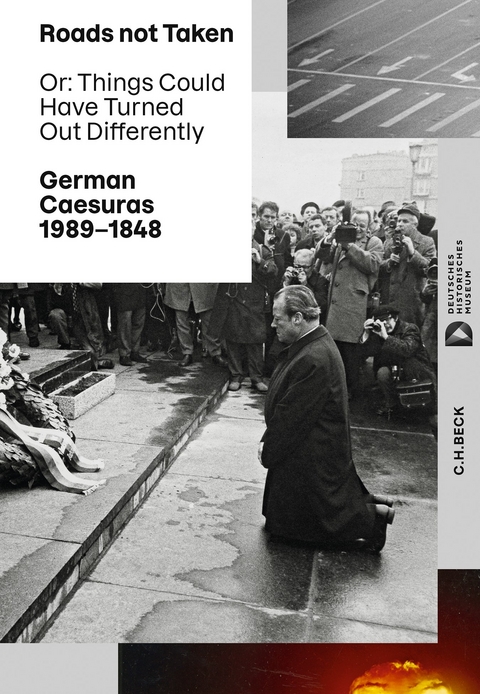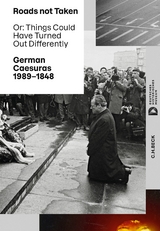Roads not Taken
What would have happened if the East German security services had violently turned on the demonstrators in 1989? If the USA had dropped atomic bombs on Germany in 1945? How would Germany have turned out if the effort to establish a constitutional monarchy had succeeded in 1848? This book accompanies the exhibition "Roads not Taken" in the Deutsches Historisches Museum, whose titel has a programmatic dimension: following a concept of the historian Dan Diner, he and the other authors focus on possible historical alternatives. What unexpected coincidences might have altered the real historical events? What role did the personalities involved play in their unfolding? Themes such as Germany's Ostpolitik, the Berlin Wall, the Cold War, the Nazi rise to power, revolution and democratization in Germany are newly evaluated in this way.
Fritz Backhaus is director of collections at the German Historical Museum and project-director of the "Roads not Taken" exhibit. Dan Diner is a contemporary historian who has taught at the Hebrew University, Jerusalem and the University of Leipzig. He was most recently director of the Simon Dubnow Institute for Jewish History and Culture. Julia Franke is a collection-head in the everyday-culture division of the German Historical Museum and curator of the "Roads not Taken" exhibit. Raphael Gross is a historian and president of the German Historical Museum Foundation. He was previously director of the Jewish Museum Frankfurt and directed the Simon Dubnow In-stitute. Stefan Paul-Jacobs is a historian and curator of the “Roads not Taken” exhibit. Lili Reyels is head of the financial and economic history division at the German Historical Museum and curator of the "Roads not Taken" exhibit.
Preface
Raphael Gross
Roads not Taken
Oder: Es hätte auch anders kommen können
A Talk with Dan Diner on the Exhibition Concepts
1989
Stroke of Luck - Revolution
What If: The Protests and Demonstrations Are Brutally Crushed
Julia Franke
1972
Détente - Ostpolitik
What If: Willy Brandt Is Voted Out of Office as Chancellor
Stefan Paul-Jacobs
April 1972: Rainer Barzel Becomes Chancellor
Bernd Rother
1961
Fear - The Berlin Wall Goes Up
What If: The Berlin Crisis Triggers a Nuclear Disaster
Stefan Paul-Jacobs
In the Government Bunker- The First Days of the Third World War
Jörg Diester
1952
Lures - The Stalin Notes
What If: The Path Leads to Reunification
Stefan Paul-Jacobs
Pictorial Space and Pictorial Time in a Socialist Utopia: Walter Womacka's Mosaic Our Life on the Haus des Lehrers in Berlin
Oliver Sukrow
1948/49
Systems - Cold War
What If: The Berlin Blockade Leads to War
Stefan Paul-Jacobs
1945
Escaped - Atomic Bomb
What If: Ludwigshafen Is Struck by an Atomic Bomb
Stefan Paul-Jacobs
1944
Assassination Attempt - 20 July
Too Late! Attempted Coup and Holocaust
Julia Franke
1936
Va Banque - Rhineland
What If: France Prevents Hitler's Expansion
Stefan Paul-Jacobs
1933
"A Miracle" - 30 January
What If: Military Dictatorship Instead of Nazi Dictatorship?
Lili Reyels
The Avoidable Catastrophe: 30 January 1933
Heinrich August Winkler
1929
Hardship - Economic Crisis
What If: Brüning Succeeds in His Policy Change
Lili Reyels
Economic Policy Debate in the Journal Der deutsche Volkswirt during the Great Depression
Roman Köster
1918
Unstable? Weimar
What If: A Monarchy Provides the Footing for a Democratic Constitution
Lili Reyels
"But the Firm ... Can and Must Be Retained": The SPD and the Question of Monarchy versus Republic
Walter Mühlhausen
1914
Abyss - August
What If: Can the Social Democrats Prevent the War?
Stefan Paul-Jacobs
Street Protests against the War in July 1914
Stefan Paul-Jacobs
1866
Empire - In the Midst
What If: A "Third Germany" Rises
Stefan Paul-Jacobs
1848/49
Failure - Revolution
What If: A Dream Comes True
Lili Reyels
Karl Biedermann's Account of the Journey of the Frankfurt Deputation
Monika Wienfort
Appendix
Literature
Authors
Lending institutions and licensers
Thanks
Illustration credits
Credits
| Erscheinungsdatum | 14.10.2023 |
|---|---|
| Zusatzinfo | with more than 90 colourful illustrations |
| Sprache | englisch |
| Maße | 165 x 240 mm |
| Gewicht | 707 g |
| Themenwelt | Sachbuch/Ratgeber ► Geschichte / Politik ► Allgemeines / Lexika |
| Geisteswissenschaften ► Geschichte ► Regional- / Ländergeschichte | |
| Schlagworte | 19. Jahrhundert • 20. Jahrhundert • Deutsches Historisches Museum • Deutschland • Geschichte • Historiographie • Zäsuren |
| ISBN-10 | 3-406-80095-5 / 3406800955 |
| ISBN-13 | 978-3-406-80095-5 / 9783406800955 |
| Zustand | Neuware |
| Informationen gemäß Produktsicherheitsverordnung (GPSR) | |
| Haben Sie eine Frage zum Produkt? |
aus dem Bereich





